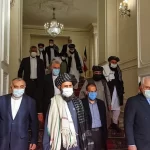Political polarisation in the US goes far beyond party politics today. It may be closer in nature to the cause of the 1860 insurrection and the terrible war that settled it, writes William Milam
It snowed late last night in Washington: perhaps a fitting end, in some metaphoric sense, to a day that marked one year since the January 6, 2020 attack on the US Capitol by the Trumpian mob trying violently – if ineptly – to overturn the 2020 election of Joe Biden. That attack desecrated the Capitol building, a primary symbol of American democracy and ended, perhaps forever, an uninterrupted 160 years of perceived confidence in that democracy as a bulwark that ensured a fundamental domestic tranquility in the United States. No longer was the peaceful transfer of power – the guaranty of such tranquility even in times of political discord – a certainty. For many Americans, this almost sacred institution was perhaps the last bastion of democracy.
The last insurrection against American democracy was when the Southern States seceded in 1860 and began a very bloody civil war which they lost in 1865 when the insurrection collapsed. The day had begun and ended with personal reminiscences of members of Congress and the Senate who were the targets of the attack and had to be hidden in the Capitol until they could certify the 2020 election of President Biden. The Capitol Police, who suffered many casualties – including several deaths – while defending the Capitol, were rightfully acclaimed as heroes. Biden spoke very powerfully at the Capitol, condemning the attack and calling it an attempt to subvert democracy and, in fact, carry out a “coup d’état, terms he has avoided in public discourse until now. Academic and media pundits from across the spectrum of the pro-democracy establishment weighed in with the same fundamental message: that US democracy is under serious threat and its failure a real possibility.
In reading a fairly wide range of analyses and essays on this threat to democracy, one aspect that has come more into focus is the rapid proliferation of extremist groups – and primarily armed extremist groups – in the past decade, which are dedicated to more authoritarian politics and policies. The number of such groups has grown exponentially since domestic intelligence agencies started counting, after Timothy McVeigh blew up the Murrah Federal building in Oklahoma City in 1995. These groups have also become less reclusive also, and were especially prominent in the January 6 attack on the Capitol. They were also prominent in public demonstrations, particularly in those which are involve hardline right-wing issues or when they seek violent clashes with left-wing demonstrators – such as those that took place during the peak of demonstration by Black Lives Matter adherents.
In short, if we can’t win counter-terrorist wars in other countries, why should we think that we can win one in the sprawling, difficult terrain of the US – where at least a third of the population is against us to start with?
It is this recent assertiveness of these groups that leads to another of the factors that seem to be important in the growing narrative of the imminent threat to democracy. It is the increasing number of articles and essays about the growing likelihood of an American civil war. I suspect these are the result of a number of analysts looking more deeply into the history of conflict and how these seemingly intractable conflicts are solved. The analysts can construct parameters that are indicators of civil war, and most analyses that I have read are alarmingly close. For example, Stephen Marche, in an article in the magazine Foreign Policy of January 4, refers to a survey done early in Donald Trump’s presidency by Thomas E. Ricks of “national security experts” to assess the chances of an American civil war sometime in the next 10-15 years. The consensus of these experts (names not provided) was 35%. Mr. Marche also mentions a 2019 poll of “registered voters” by Georgetown University asking to give a number between 1 and 100 for how close to “the edge of civil war” the US was; the mean number of 67.23 came back: meaning two-thirds of the way. I am not citing these examples as evidence that a civil war is close; in fact, they do not prove anything much except that some analysts will use any evidence to emphasise a point. But the growing acceptance of an inevitable American civil war may actually make it more likely.
And what would an American civil war look like? Most Americans who think about it, and possibly even some who write about it, are like to think of two armies fighting pitched battles in huge fields like the civil war scenes we see in the movies. Perhaps, one of those armies would be made up of the extremist militias. But how long could all the militia groups together stand up in combat against a division of US Marines for even a day? Professional militaries are professional. No, the civil war would look like the war we just lost in Afghanistan: an asymmetrical war, with US troops chasing small units of irregulars equipped with asymmetrical weapons and using the hit-and-run tactics of guerillas. Even though the inhabitants are American, they soon become alienated by the tactics that a dominant military has to use to get on top of guerilla situations – which involves a lot of seizes and searches and other counter-terrorist tactical measures. And of course, it is inevitable that they will have sympathisers among the public who may be helpful.
In short, if we can’t win counter-terrorist wars in other countries, why should we think that we can win one in the sprawling, difficult terrain of the US – where at least a third of the population is against us to start with? These are the kind of wars we have been losing for the last three decades. Finally, if you look at the Wikipedia list of the battles of the Revolutionary War, the Americans won some important ones (with important help from the French), and had some “moral” victories too, but the British Army won the majority of the formal battles; yet the Americans won the war.
This concern about a coming civil war, which is important to think about, has been part of the American political narrative since 2016, but until the January 6 attack last year had limited resonance. It has grown more powerful and incisive in the year since the attack and will, I expect, be an important adjunct to the political narrative through this year and likely through the following two years that lead to the election in 2024. While the current threat to democracy is treated often as a partisan issue, it is really deeper than that, closer in nature to the cause of the 1860 insurrection and the terrible war that settled it. Perhaps we should view it through the same lens: as a fundamental difference in two belief systems that cannot be settled by democracy, which is a way to conduct political systems that requires compromise. There are a number of such conflicts in which politics is the only way to a solution, but not always a very good one.
It seems to me that the history of that first insurrection leads us to this conclusion. In 1860, there was no way to settle the problem of slavery, or so both sides firmly believed. The political solution was to agree to secession. But the Constitution does not allow for secession; for after all, few constitutions do allow for secession. The only solution was war.
War is sometimes a necessary – though not usually sufficient – solution to a moral issue like slavery. There could be no compromise between slavery and freedom. When there is such a compromise, which was the eventual outcome of the civil war, then it is freedom that takes the hit, and humans, and humanity, that suffer the consequences. Only if each side understands that winning or losing will entail serious political and perhaps military responsibilities – to both the winner and the loser – could war be a viable option to settling a moral issue. The winner will face the responsibility of governing a loser who hates being governed by the winner, and the loser will face the responsibility will face perhaps a long period of being governed by the winner and ultimately living under the belief system of the winner. If you think about this, you will realize that it is a lot like the counter insurgency wars the US has fought in the last 3 decades. Reigning over a hostile population and trying to get it to do things you want and to think like you is not a formula for winning hearts and minds. And a little further thought will bring you to the realization, that that those kinds of wars we tend to lose in a process that can easily reduce our own freedoms.




Comments